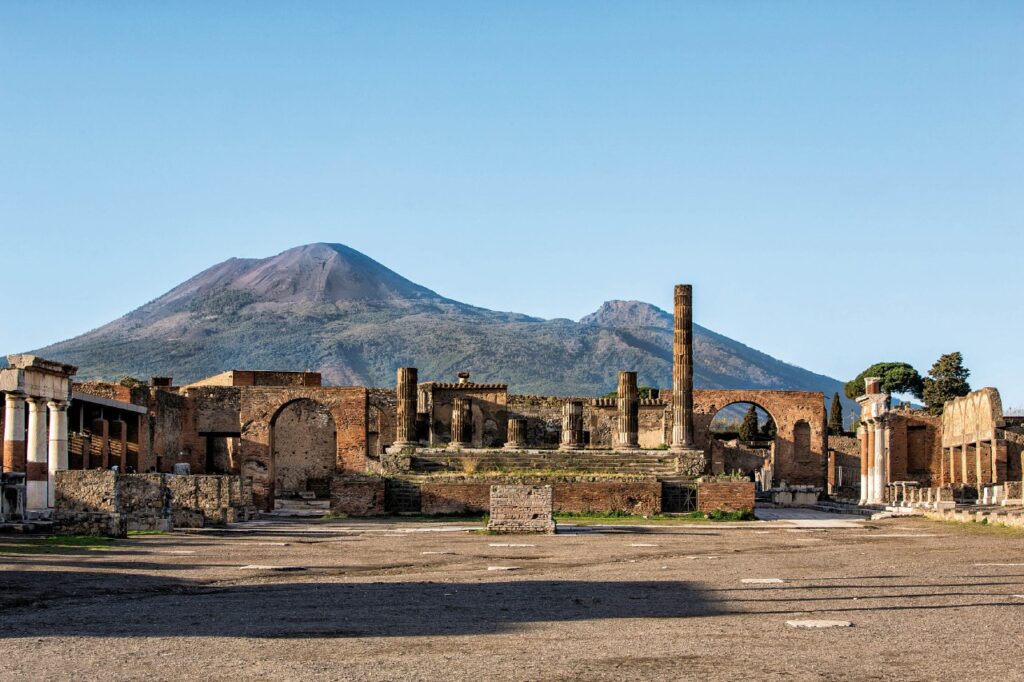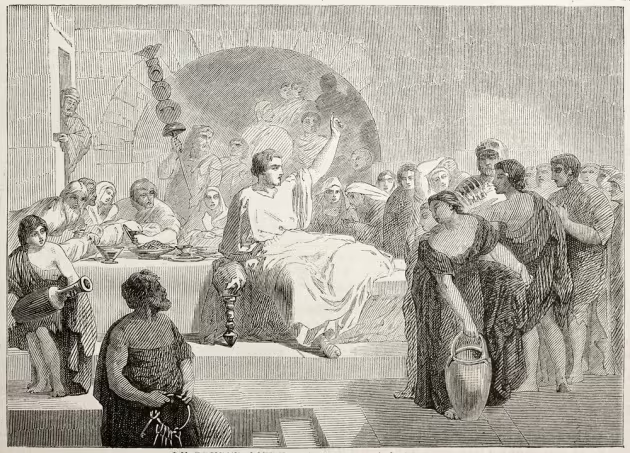Panis Quadratus Pompei
Svelati i misteri sui solchi dei pani carbonizzati
di Marco Pirollo
La furia del Vesuvio, in quei maledetti giorni del 79 d.C., carbonizzò tutto a Pompei e nelle città vicine, anche i pezzi di pane che erano custoditi nei forni e nelle botteghe, pronti ad essere venduti e a sfamare intere famiglie. Tanti di quei pani, purtroppo, non furono mai mangiati e sono stati ritrovati praticamente integri durante i lavori di scavo, a partire dal XVIII secolo. Sappiamo, quindi, che il tipo di pagnotta più diffusa era il Panis Quadratus (o Panis Siligineus): realizzata con acqua, farina di grano tenero e lievito madre, di forma circolare, era suddivisa verticalmente in otto porzioni (spicchi) identiche e presentava una sorta di scanalatura in orizzontale lungo tutta la circonferenza. Insomma è il pezzo di pane che siamo abituati a vedere (carbonizzato) quando si parla del pane di Pompei.
Eppure quella forma così conosciuta e familiare desta tuttora molta curiosità e nasconde ancora tanti segreti, cui sta cercando di dare una risposta l’archeologa canadese (ma residente in California) Farrell Monaco, esperta di archeologia dell’alimentazione: la sua ricerca si concentra sul cibo, sulle tecniche di preparazione e sulle ceramiche legate al cibo nel Mediterraneo romano.

Negli ultimi anni, infatti, la ricerca di Monaco si è incentrata sulle panetterie pompeiane e sulle tipiche pagnotte carbonizzate di “Panis Quadratus” ritrovate. Quindi, seguendo la ricetta ricavata da testi antichi, affreschi e ricerche archeologiche, ha riprodotto il pane pompeiano con l’obiettivo di comprenderne il processo di preparazione, le proporzioni degli ingredienti, le caratteristiche durante l’impasto, la cottura e… il sapore. «I pani, in media – spiega l’archeologa canadese – misuravano 20 centimetri di diametro ma oscillavano, a causa della composizione, della temperatura del forno o della dilatazione, da 18 a 22 centimetri circa.
Il Panis Quadratus era ottenuto da un grano che era spesso macinato e setacciato più volte, affinato in una delicata farina che veniva chiamata siligo: da qui, quindi, l’altro nome spesso usato quando si fa riferimento a questo pane, Panis Siligineus».

Ma come veniva suddiviso in otto spicchi? E per quale ragione? «I solchi che creano gli otto spicchi nella parte superiore del pane non sono tagli di coltello nella parte superiore dell’impasto, come si pensava in precedenza: piuttosto essi vengono impressi nell’impasto» spiega Farrell Monaco. L’ipotesi dell’archeologa, quindi, è che quei solchi venissero ottenuti con un oggetto somigliante ad una ruota di carro (a otto raggi) in miniatura, che veniva pigiata sull’impasto, anche se niente di simile è stato rinvenuto a Pompei. Relativamente al motivo di quella suddivisione, invece, Monaco ha ipotizzato che «gli otto spicchi sulla parte superiore della pagnotta probabilmente venivano fatti per essere spezzati più facilmente e usati come “utensili da cucina commestibili” per accompagnare stufati, zuppe e legumi».

La studiosa ha cercato di capire anche perché i pezzi di Panis Quadratus avessero un ulteriore solco in senso orizzontale intorno all’intera circonferenza (una sorta di “cintura”) e il modo in cui tale segno venisse ottenuto. Nel suo esperimento, Farrell Monaco ha riprodotto il solco con «uno spago da giardino pesante e non trattato» e l’ha «legato delicatamente attorno al pane prima di cuocerlo». Non è certo che gli antichi pompeiani usassero lo stesso strumento, ma il risultato finale del prodotto è stato ritenuto compatibile con i pani carbonizzati ritrovati a Pompei. L’archeologa ha quindi dedotto che quell’espediente servisse a ridurre l’espansione dei pani, dovuta al calore e alla presenza di lievito, durante la cottura in forno. Tutto svelato, dunque, riguardo al Panis Quadratus? Non proprio. Un ultimo dubbio permane su come ottenere l’abbassamento che si nota al centro delle pagnotte carbonizzate.
Panis Quadratus
Pompeii
The mysteries of the carbonized loaves of bread revealed
by Marco Pirollo
The fury of Vesuvius, in those cursed days of 79 AD, carbonized everything in Pompeii and the nearby cities, even the pieces of bread that were kept in the ovens and shops, ready to be sold and to feed entire families. Many of those loaves, unfortunately, were never eaten and were found practically intact during excavation work, starting in the 18th century. We know, therefore, that the most common type of loaf was the Panis Quadratus (or Panis Siligineus): made with water, soft wheat flour and sourdough, circular in shape, it was divided vertically into eight identical portions (segments) and had a sort of horizontal groove along the entire circumference. In short, it is the piece of bread that we are used to seeing (carbonized) when we talk about the bread of Pompeii. Yet that well-known and familiar shape still arouses much curiosity and hides many secrets, which Canadian archaeologist (but resident in California) Farrell Monaco, an expert in food archaeology, is trying to answer: her research focuses on food, preparation techniques and ceramics related to food in the Roman Mediterranean. In recent years, in fact, Monaco’s research has focused on Pompeian bakeries and the typical charred loaves of “Panis Quadratus” found there. Then, following the recipe obtained from ancient texts, frescoes and archaeological research, she reproduced Pompeian bread with the aim of understanding the preparation process, the proportions of the ingredients, the characteristics during kneading, cooking and… the flavour. “The loaves, on average – explains the Canadian archaeologist – measured 20 centimetres in diameter but varied, due to the composition, the temperature of the oven or the expansion, from about 18 to 22 centimetres. Panis Quadratus was made from a grain that was often ground and sifted several times, refined into a delicate flour that was called siligo: hence the other name often used when referring to this bread, Panis Siligineus. But how was it divided into eight wedges? And for what reason? “The grooves that create the eight wedges on the top of the bread are not knife cuts in the top of the dough, as previously thought: rather, they are impressed into the dough,” explains Farrell Monaco. The archaeologist’s hypothesis, therefore, is that those grooves were obtained with an object resembling a miniature (eight-spoke) wagon wheel, which was pressed into the dough, even if nothing similar has been found in Pompeii. Regarding the reason for that division, Monaco instead hypothesized that «the eight segments on the upper part of the loaf were probably made to be broken more easily and used as “edible kitchen utensils” to accompany stews, soups and legumes». The scholar also tried to understand why the pieces of Panis Quadratus had an additional groove in a horizontal direction around the entire circumference (a sort of “belt”) and how this sign was obtained. In her experiment, Farrell Monaco reproduced the groove with «a heavy and untreated garden string» and «tied it delicately around the bread before baking it». It is not certain that the ancient Pompeians used the same tool, but the final result of the product was considered compatible with the carbonized loaves found in Pompeii. The archaeologist therefore deduced that this expedient served to reduce the expansion of the loaves, due to heat and the presence of yeast, during baking in the oven. So, is everything revealed about Panis Quadratus? Not quite. One last doubt remains about how to obtain the depression that is noticeable in the center of the charred loaves.
